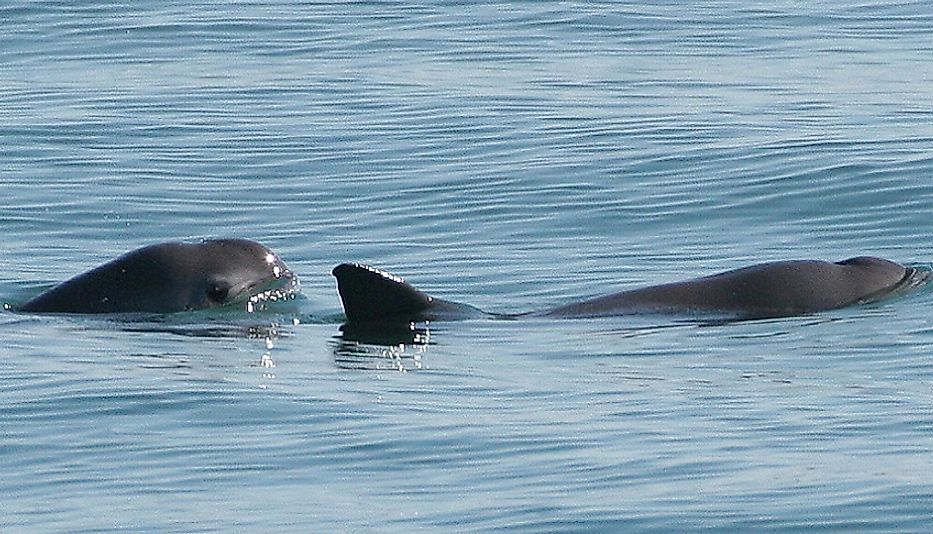Vaquitas - Rare Animals Of Mexico

The vaquitas (Phocoena sinus) are considered to be the world's most endangered cetacean, numbering only 12-15 as per the population estimates of March 2018. These porpoises, endemic to the Gulf of California in Mexico, have been listed as critically endangered by the Internation Union for the Conservation of Nature (IUCN) since 1996.
5. Physical Description
The vaquitas are the smallest cetaceans measuring only about 120 to 150 centimeters in length and weighing around 55 kilograms. The female vaquitas are generally slightly larger than the males of the species. The skin of the vaquitas range from dark grey on the dorsal surface to light grey to white on the ventral surface. Dark circles surround the eyes and mouth of these porpoises and a dark stripe runs down from its chin to the base of its flippers. It is believed that the slender body and broad fins of the vaquitas help them maintain a normal body temperature in the warm waters inhabited by them.
4. Diet and Behavior
Vaquitas hunt and feed on demersal and benthic fish species in their habitat. They usually forage in the lagoons where they use echolocation to detect the presence of fish. The fishes most commonly consumed by the vaquitas include sea trout, grunts, and croakers. Vaquitas are usually solitary species except when the mothers are accompanied by their calves. On rare occasions, groups of 10 or more vaquitas have been sighted. These porpoises are thus not as sociable as the other closely related cetaceans like the dolphins. They also are evasive in nature surfacing above the water for only a brief period to breathe and then quickly disappearing into the depths of the ocean.
3. Habitat and Range
The vaquitas inhabit shallow, murky lagoons near the coastlines where conditions are ideal for the availability of a large numbers of fish, crustaceans and squids, all of which serve as food for the vaquitas. These porpoises prefer to forage in shallow waters up to a depth of only 100 feet. They can be sighted in coastal waters that are about 11 to 25 kilometers away from the coast and in water depths between 36 and 160 feet. They have the most limited range among the other cetaceans of the world and are only found in the northern parts of the Gulf of California.
2. Reproduction and Life Cycle
The vaquitas have an extremely slow rate of reproduction, producing only one calf within a period of 1 to 2 years which is also one of the factors responsible for its plummeting numbers. Since vaquitas are elusive in nature, very little is known about their life cycle and reproduction and most of the data is derived by studying the captured individuals of this species. The animals sexually mature between the ages of 3 and 6, and mate between late spring and early summer. After a gestation period of about 10 to 11 months, they produce only a single calf. The calf stays with the mother for about 6 to 8 months and then is ready to live an independent life.
1. Threats and Conservation
The greatest threat to vaquita survival is the problem of bycatch. These porpoises are often caught unintentionally in the fishing gear used to fish for shrimps and other fishes in the coastal waters. As per estimates, nearly 39 vaquitas die every year as a result of being caught in gill-nets set to catch other aquatic species. Besides bycatch, vaquitas are also threatened by the decreasing water volumes in their habitat. The Colorado River is largely emptied for domestic consumption purposes throughout its basin and thus its water level is heavily lowered as it flows into the Gulf of California. Agricultural run-offs and toxic chemicals also drain into the gulf, further threatening the survival of the vaquitas. Recognizing the immediate need to save them, the Mexican Government has established the International Committee for the Recovery of the Vaquita (CIRVA) to monitor and protect the vaquitas in their natural habitat. A large area of the vaquita habitat has been declared a nature reserve and plans are on to extend this area further to include the entire range of these animals. Trawling and other commercial fishing activities are completely banned within the nature reserve. Plans are also being made to provide an alternative sustainable employment source to the local fishermen in the Gulf to distract them from fishing in vaquita habitat. The plight of the vaquita is being featured in the "Sea of Shadows" documentary.











